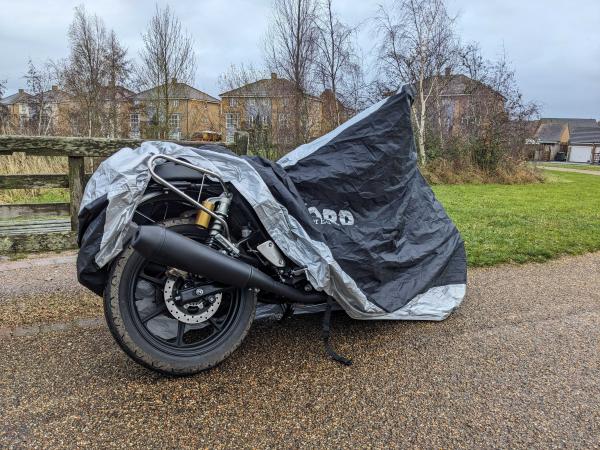
As we publish this piece, we’re in the depths of winter, and the weather’s probably going to worse before it gets better. We’re going to assume that if you have a garage, a shed or a motorcycle shelter garage, you won’t be reading this. And speaking of motorcycle shelter garages, these affordable, semi-permanent storage solutions are great if you have a parcel of land in which to bolt one down, but for most of us in need of all-weather protection, they’re simply not a practical option. So, let’s start with the basics:
Get a cover that fits your bike
It’s not a one-size-fits-all-all consideration - if you’ll pardon the pun - when buying a bike cover. These bikini covers (Bike It does one for under twenty quid) might be okay to stop your seat from getting wet after a spring shower, but they’re not going to keep the hailstones off your chain, wheel rims and fancy can. So, unless it's just something to keep your bike dry when parked up after the morning commute, forget it.
Similarly, attempting to protect your Honda CBR300R over winter with LUYAO’s Honda Goldwing cover is akin to dressing a toddler in a trench coat. With all that additional material flapping about, oversized covers can do more harm than good when the wind gets up, like scratching and spanking your paintwork or even pulling your bike over.
Condensation
Condensation is a natural part of the evaporation process, which changes liquid water to gas, and there’s not much you can realistically do about it. Sure, you can prevent too much condensation from building up by buying into features like cover vents, but then you’re compromising the product's ability to repel proper water, like pouring rain. You’re never going to get rid of condensation, but you might pay over the odds in a fruitless effort to defeat it. Do the maths, as they say.
Belly straps: a warning
It doesn’t matter how good a cover is if it takes you twenty minutes to get it on and off your bike. I’ve been known to get a cover on in seconds: you know the drill, you lift it up and a friendly gust of wind inflates it enabling you to drop it exactly into position - it’s quite beautiful when that happens, man… Only to spend the next thirty minutes on your knees fumbling for the billowing strap before sort of trying to flick it under the belly pan in the vague hope it’ll rest undisturbed while you run to the other side of the bike to snap it home. For me, if a cover relies on a belly strap to secure the cover, I’m not interested.
Instead, this cheapo offering from RnCop is a good alternative for those who feel the same. It’s under 20 quid, which means that even if it only lasts you a couple of years, you’ve done well- and it has front and rear straps that easily attach to the wheels and there’s a cord around the hem allowing you to adjust it as required.
RnCop cover - view deal
Do your research
Some of the most popular motorcycle all-weather covers are made by Oxford. The Stormex, for example, is highly rated and yours for under £60 if you shop around. One of the best things about the Storemex is its availability in different sizes, which sounds splendid, but long-term testimonies might offer a completely different story with a seriously unhappy ending, so do your research over and above the gushing just-bought reviews.
Oxford Stormex - view deal
Be pragmatic
It’s a bike cover, folks. It’s designed to keep the worst of the British weather off your bike, not protect it from tropical cyclones and/or outlast the sun, so buy something waterproof that fits your bike and is easy to get on and off. That’s it.
On a final note, the cheaper your cover looks, the less likely it’s going to draw attention to sticky-fingered ne'er-do-wells: covering rips and tears with Waterproof Gorilla Tape could even be a better option than buying new.

